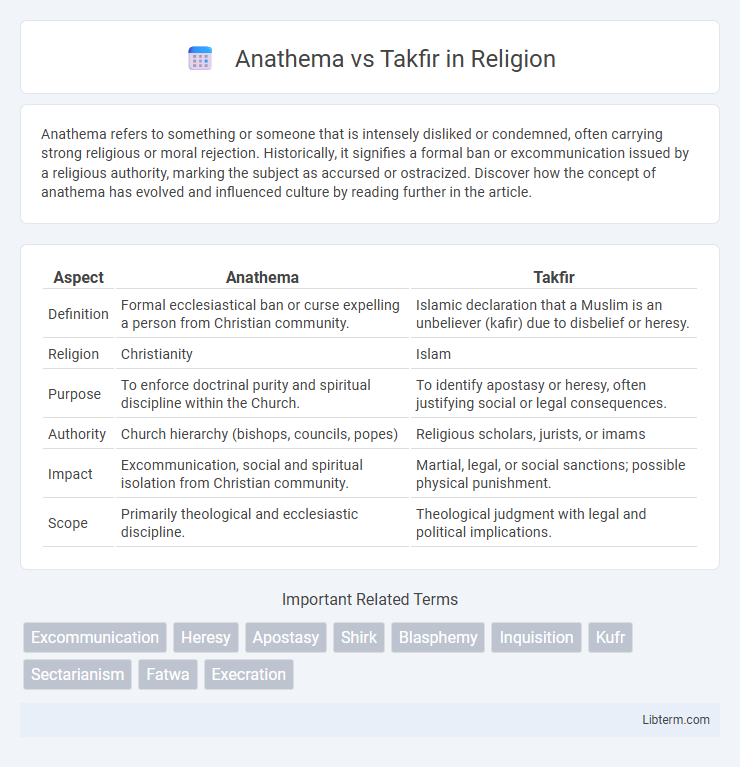Anathema refers to something or someone that is intensely disliked or condemned, often carrying strong religious or moral rejection. Historically, it signifies a formal ban or excommunication issued by a religious authority, marking the subject as accursed or ostracized. Discover how the concept of anathema has evolved and influenced culture by reading further in the article.
Table of Comparison
| Aspect | Anathema | Takfir |
|---|---|---|
| Definition | Formal ecclesiastical ban or curse expelling a person from Christian community. | Islamic declaration that a Muslim is an unbeliever (kafir) due to disbelief or heresy. |
| Religion | Christianity | Islam |
| Purpose | To enforce doctrinal purity and spiritual discipline within the Church. | To identify apostasy or heresy, often justifying social or legal consequences. |
| Authority | Church hierarchy (bishops, councils, popes) | Religious scholars, jurists, or imams |
| Impact | Excommunication, social and spiritual isolation from Christian community. | Martial, legal, or social sanctions; possible physical punishment. |
| Scope | Primarily theological and ecclesiastic discipline. | Theological judgment with legal and political implications. |
Introduction to Anathema and Takfir
Anathema refers to a formal ecclesiastical ban or curse pronounced against a person or doctrine, often signifying complete excommunication or condemnation within Christian contexts. Takfir is an Islamic term describing the act of declaring a Muslim to be an unbeliever or apostate, frequently used in doctrinal disputes to ostracize individuals or groups. Both concepts involve religious exclusion but operate under distinct theological frameworks and implications within Christianity and Islam, respectively.
Historical Origins of Anathema
Anathema originated in early Christian theology as a formal ecclesiastical ban or excommunication used to denounce heresy and exclude individuals from the community, particularly evident in the writings of the Church Fathers during the first millennium. It served as a doctrinal tool to enforce orthodoxy within the Byzantine Church and Western Christianity, especially during the Councils of Nicaea and Chalcedon, which codified key theological positions. This practice contrasted with Takfir in Islamic tradition, where the declaration involves excommunicating a Muslim for apostasy or disbelief based on Sharia principles.
Historical Roots of Takfir in Islamic Thought
Takfir, the act of declaring a Muslim an apostate, draws its historical roots from early Islamic theological debates surrounding heresy and orthodoxy, particularly during the Abbasid period when various sects contested religious legitimacy. Unlike anathema, predominantly a Christian ecclesiastical censure used to excommunicate heretics, takfir carries severe religious and legal implications in Islamic jurisprudence. Its usage evolved significantly during political conflicts, influencing sectarian divisions and shaping contemporary discourses on religious identity and apostasy in Muslim societies.
Defining Anathema: Meaning and Usage
Anathema traditionally refers to a formal ecclesiastical ban or excommunication, often signifying profound condemnation or curse within religious contexts. Its usage extends to denote something or someone vehemently detested or shunned, emphasizing extreme rejection. Unlike Takfir, which specifically labels a Muslim as an infidel, Anathema carries broader application in both religious and secular denunciations.
Understanding Takfir: Concept and Application
Takfir refers to the practice of declaring a Muslim as an unbeliever or apostate, often based on perceived deviations from Islamic doctrine, which significantly impacts intra-Muslim relations and jurisprudence. Understanding Takfir requires examining its theological basis in Islamic law, the criteria for pronouncing it, and its historical application by various groups, including those with militant or sectarian agendas. The concept contrasts with anathema, which is a formal ecclesiastical condemnation in Christian contexts, highlighting the distinct religious and legal frameworks governing excommunication and apostasy across faith traditions.
Theological Implications of Anathema in Christianity
Anathema in Christianity signifies formal ecclesiastical condemnation that expels individuals from the community of faith and marks them as heretics, reflecting a profound theological judgment on doctrinal purity. This concept emphasizes the gravity of deviation from core Christian beliefs, particularly those defined by ecumenical councils, and serves as a deterrent against heresy by delineating the boundaries of orthodox doctrine. In contrast, Takfir in Islam also involves declaring a Muslim an unbeliever but differs in its application and theological implications, highlighting divergent approaches to heresy and community exclusion between the two religions.
The Doctrine of Takfir: Controversies and Debates
The doctrine of Takfir, which involves declaring a Muslim an unbeliever, has sparked intense theological controversies and debates within Islamic scholarship, causing deep sectarian rifts. It challenges core principles of faith and community unity, with critics arguing that misuse of Takfir leads to unjust excommunication and violence. Debates focus on stringent criteria for Takfir and its impact on intra-Muslim relations, highlighting tensions between orthodox interpretations and reformist perspectives.
Comparison: Anathema versus Takfir
Anathema and Takfir both involve declaring someone outside the bounds of a religious community, but they differ significantly in scope and usage. Anathema, rooted in Christian tradition, is a formal ecclesiastical censure condemning a person or doctrine as heretical, often leading to excommunication or complete severance from the Church. Takfir, an Islamic concept, involves declaring a Muslim as an apostate or unbeliever, a serious accusation that can carry legal and social consequences within Islamic jurisprudence.
Social and Political Impact of Anathema and Takfir
Anathema and Takfir deeply influence social cohesion and political dynamics by shaping group identities and legitimizing exclusion or violence against perceived heretics. Anathema often fosters social ostracism and reinforces ideological boundaries within religious or ideological communities, while Takfir can escalate conflicts by justifying accusations of apostasy or betrayal, frequently serving as a tool for political power struggles and radicalization. These practices impact governance, law enforcement, and community relations, intensifying sectarian divisions and fueling cycles of mistrust and violence.
Conclusion: Lessons from Anathema and Takfir
Anathema and Takfir, as concepts of excommunication and apostasy respectively, highlight the dangers of rigid ideological boundaries in religious discourse. Both practices underscore the importance of promoting tolerance and critical reflection to prevent sectarianism and social division. Lessons from their application emphasize fostering dialogue and understanding to maintain unity within diverse faith communities.
Anathema Infographic

 libterm.com
libterm.com